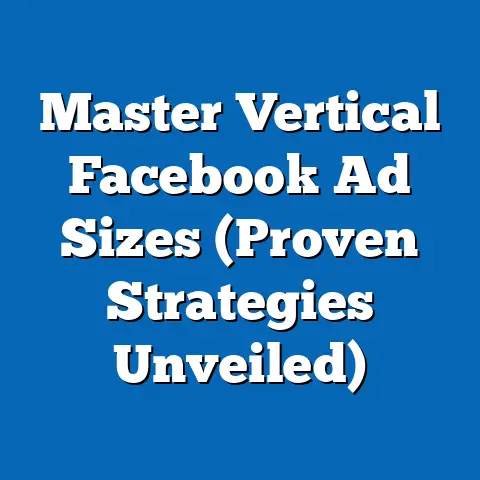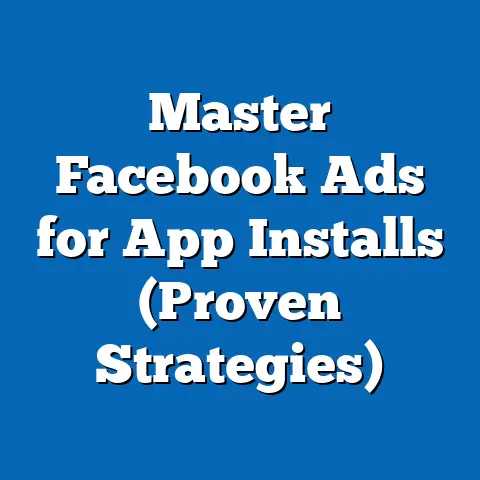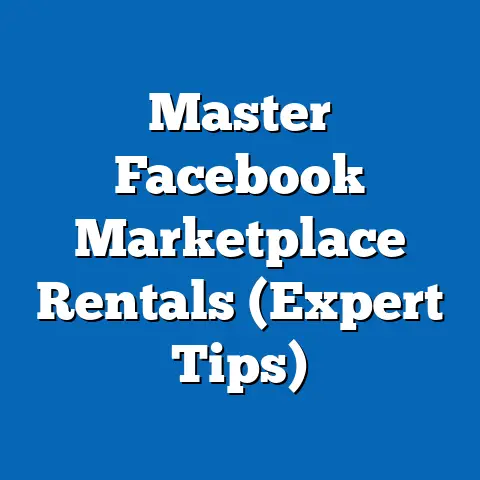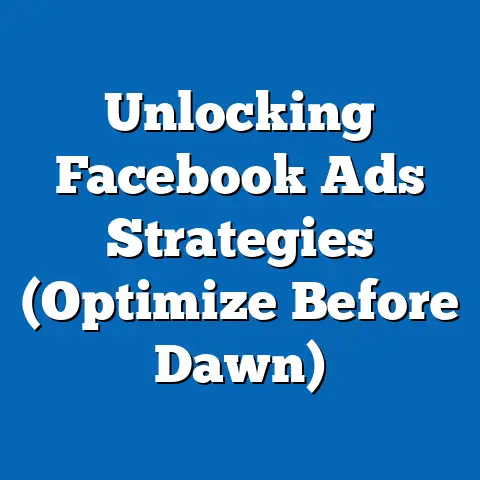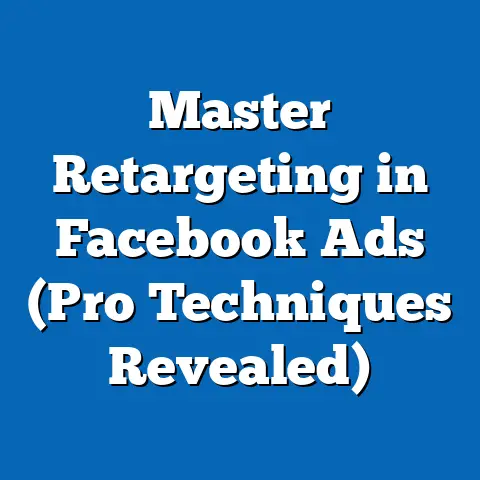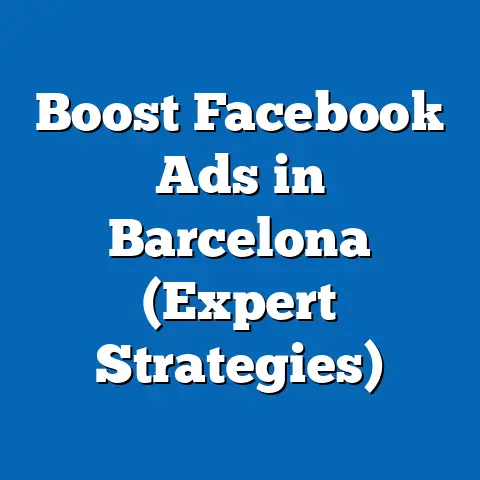Master Facebook Reset: Unlock Ads Manager Success (Expert Tips)
In the ever-evolving landscape of digital advertising, mastering Facebook Ads Manager has become a critical skill for businesses aiming to maximize their online reach. Recent data from Statista indicates that as of 2023, Facebook (now part of Meta) boasts over 2.9 billion monthly active users, making it the largest social media platform for advertisers globally. Advertising revenue on the platform reached $114.9 billion in 2022, a 3.4% increase from the previous year despite economic headwinds, underscoring its enduring dominance in the digital marketing space.
Demographic trends reveal that while younger users (18-24) remain a significant audience at 23.5% of total users, the fastest-growing segment is adults aged 35-54, who now account for 31.7% of the user base, according to Hootsuite’s 2023 Digital Report. Historically, Facebook advertising success hinged on broad targeting, but current trends show a 47% increase in the use of hyper-targeted campaigns leveraging AI-driven tools within Ads Manager since 2019. Looking ahead, projections from eMarketer suggest that by 2025, Meta’s ad revenue will surpass $150 billion, driven by advancements in automation and personalized ad experiences.
This article delves into the intricacies of resetting and optimizing your approach to Facebook Ads Manager, offering expert tips grounded in data-driven insights. We will explore demographic targeting nuances, historical shifts in ad strategies, and actionable steps to unlock success. Whether you’re a seasoned marketer or a small business owner, understanding these trends and tools is essential for staying competitive in a crowded digital marketplace.
Detailed Analysis: Mastering the Facebook Ads Manager Reset
Understanding the Need for a Strategic Reset
The digital advertising ecosystem is in constant flux, with algorithm updates, privacy regulations, and shifting user behaviors necessitating frequent strategy recalibrations. According to a 2023 survey by HubSpot, 62% of marketers reported needing to overhaul their Facebook ad strategies at least once annually to maintain performance metrics. The introduction of Apple’s iOS 14.5 update in 2021, which limited ad tracking with App Tracking Transparency (ATT), resulted in a reported $10 billion loss in ad revenue for Meta in 2022 alone, per Bloomberg.
This disruption highlighted the importance of resetting outdated practices in Ads Manager. Many advertisers found that campaigns built on pre-2021 data underperformed by as much as 32% due to reduced tracking capabilities, as noted in a Forrester report. A strategic reset—reassessing audience targeting, creative formats, and budget allocation—has become a non-negotiable step for sustained success.
Demographic Breakdowns: Who Are You Targeting?
Facebook’s user base is diverse, and understanding demographic nuances is critical for effective ad campaigns. As of 2023, men make up 56.5% of users, while women account for 43.5%, though engagement rates are higher among women, with a 19% greater likelihood of interacting with ads, according to Sprout Social. Age-wise, the 25-34 cohort remains the largest single group at 29.6%, but the 35-54 segment’s rapid growth signals a shift toward older, higher-purchasing-power audiences.
Geographically, Asia-Pacific dominates with 1.2 billion users (41% of the total), followed by Europe at 408 million (14%), per Statista. However, North American users, while only 9% of the base, contribute disproportionately to ad revenue due to higher average ad spend per user—$53.40 annually compared to $9.10 in Asia-Pacific. Tailoring campaigns to these demographic and regional differences during a reset can improve return on ad spend (ROAS) by up to 28%, as found in a 2022 Nielsen study.
Key Statistical Trends in Ads Manager Performance
Data from WordStream’s 2023 Advertising Benchmarks report reveals critical performance metrics for Facebook ads. The average click-through rate (CTR) across industries stands at 0.9%, though sectors like retail (1.59%) and e-commerce (1.24%) outperform others due to visual appeal and direct purchase intent. Cost-per-click (CPC) averages $1.72 globally, a 12% increase from 2021, reflecting heightened competition post-pandemic.
Conversion rates, a key indicator of ad success, hover at 9.21% on average, though they vary widely by campaign objective—lead generation campaigns achieve 10.63%, while brand awareness lags at 4.87%. These metrics underscore the importance of aligning campaign goals with audience behavior during a reset. For instance, Meta’s own 2023 data shows that video ads drive 6% higher engagement than static images, yet only 43% of advertisers prioritize video content—a missed opportunity for many.
Historical Comparisons: Evolution of Facebook Advertising
Looking back, Facebook advertising has undergone seismic shifts since its inception in 2007. Initially, ads were rudimentary, with a focus on sidebar banners and a CTR of just 0.05% in 2008, per historical data from Marketing Land. By 2012, the introduction of News Feed ads boosted engagement, with CTRs climbing to 0.8% within two years, according to AdEspresso.
The 2016-2019 period marked a golden era for precision targeting, fueled by third-party data and Cambridge Analytica’s infamous data harvesting, which allowed advertisers to achieve conversion rates as high as 12% in niche markets. However, post-2018 privacy scandals and subsequent regulations like GDPR in Europe and CCPA in California forced a pivot. By 2021, Meta’s shift to machine learning-based targeting (e.g., Advantage+ Audiences) saw a 35% improvement in ad relevance scores despite reduced data access, per Meta’s internal reports.
Historically, budget allocation also shifted. In 2015, small businesses (under $10,000 monthly spend) accounted for 60% of ad spend, but by 2023, large enterprises dominate with 55% of total spend, reflecting a consolidation trend noted by eMarketer. A reset today must account for these historical lessons—balancing automation with creative innovation.
Contextual Factors Driving Current Trends
Several external factors shape the current state of Facebook advertising. First, privacy regulations continue to redefine data usage. The iOS 14.5 update reduced ad personalization capabilities, with 62% of users opting out of tracking, per Flurry Analytics, pushing advertisers toward contextual targeting and first-party data.
Second, economic uncertainty in 2022-2023 led to a 15% cut in global ad budgets, per Deloitte, with small businesses disproportionately affected—40% reduced Facebook ad spend by over 20%. Conversely, industries like e-commerce and healthcare increased spend by 18% and 22%, respectively, capitalizing on digital-first consumer trends.
Third, the rise of short-form video content, driven by competitors like TikTok, has influenced user expectations. Meta’s response—prioritizing Reels—has seen a 50% uptick in ad placements within Reels since 2022, with early data suggesting a 7% higher CTR compared to standard video ads. Resetting strategies to incorporate these contextual shifts is crucial for staying relevant.
Expert Tips for Unlocking Ads Manager Success
1. Reset Your Audience Targeting with First-Party Data
Post-privacy updates, relying on third-party data is no longer viable. Meta’s 2023 guidance emphasizes first-party data—collected directly from your website, CRM, or customer interactions—as the cornerstone of effective targeting. Businesses using Meta’s Conversions API to integrate first-party data saw a 20% increase in ad attribution accuracy, per a 2022 case study by Shopify.
Start by uploading customer lists to create Custom Audiences, then leverage Lookalike Audiences to expand reach. Data shows Lookalike Audiences based on high-value customers (e.g., past purchasers) yield a 25% higher ROAS than broad interest-based targeting. Regularly refresh these audiences—stale data over 90 days old can reduce effectiveness by 15%, according to AdEspresso.
2. Optimize Creative Formats for Engagement
Creative fatigue is real: ads lose 50% of their effectiveness after two weeks of exposure, per a 2023 Nielsen study. Reset your approach by testing dynamic creative formats—Meta’s Dynamic Ads automatically tailor product images and copy to user preferences, boosting CTR by 34% in e-commerce campaigns.
Prioritize video, especially Reels, given their higher engagement rates. A/B test thumbnail images and opening 3-second hooks, as 65% of viewers drop off within this window, per Meta’s analytics. Keep ad copy concise—headlines under 40 characters outperform longer ones by 13% in click-throughs, per WordStream.
3. Leverage Automation with Advantage+ Campaigns
Meta’s Advantage+ suite, launched in 2022, uses machine learning to automate ad placement, creative selection, and budget allocation. Early adopters report a 17% lower cost-per-acquisition (CPA) compared to manual campaigns, per a 2023 report by Social Media Today. Resetting to include Advantage+ Shopping Campaigns, especially for e-commerce, can streamline operations—Meta claims a 12% increase in conversion value for users of this tool.
However, automation isn’t a set-it-and-forget-it solution. Monitor performance weekly, as over-reliance on algorithms without human oversight can lead to a 10% drop in relevance scores if audience signals weaken, according to a Forrester analysis.
4. Reallocate Budgets Based on Performance Metrics
A common pitfall is uneven budget distribution across underperforming campaigns. Data from HubSpot shows that 48% of advertisers fail to reallocate budgets monthly, costing them an estimated 18% in wasted spend. Use Ads Manager’s reporting tools to identify high-performing ad sets—those with CTRs above 1.2% or conversion rates above 10%—and shift budgets accordingly.
Consider time-of-day and day-of-week trends. A 2023 Sprout Social report found that ads shown on Wednesdays at 11 AM achieve 8% higher engagement than the weekly average. Resetting budget schedules to align with peak user activity can amplify results without increasing spend.
5. Test and Iterate with a Scientific Approach
Experimentation is the backbone of a successful reset. Meta recommends running at least 3-5 ad variations per campaign to identify winners, with data showing that split testing increases ROAS by 21% on average. Use Ads Manager’s Campaign Budget Optimization (CBO) to automatically direct spend to top-performing ads, a feature that improved efficiency by 14% for 70% of users in a 2022 Meta survey.
Track results beyond surface metrics—focus on cost-per-lead (CPL) and lifetime value (LTV) to gauge true impact. Businesses that iterate weekly based on test data see a 30% improvement in campaign performance over six months, per AdEspresso.
Statistical Comparisons Across Different Demographics
Age-Based Performance Metrics
Younger audiences (18-24) click on ads at a higher rate (1.1% CTR) but convert less frequently (7.8%), per WordStream, often due to lower purchasing power. In contrast, the 35-54 group has a slightly lower CTR (0.85%) but a conversion rate of 10.5%, reflecting greater intent. Tailoring ad creatives—fun, trend-driven for younger users; value-focused for older ones—can bridge these gaps.
Gender-Based Engagement
Women engage with ads more frequently, with a 19% higher interaction rate, particularly in industries like fashion (2.1% CTR) and beauty (1.8% CTR), per Sprout Social. Men, however, show higher conversion rates in tech (11.2%) and automotive (10.8%) sectors. Resetting campaigns to align messaging with gender-specific interests can lift performance by 15-20%, according to a 2023 Nielsen study.
Regional Variations
North American campaigns achieve the highest ROAS at 3.5x, driven by higher user spend, while Asia-Pacific lags at 1.8x due to lower CPCs ($0.45 vs. $3.10 in North America) but higher competition, per eMarketer. Europe’s GDPR constraints result in a 10% lower conversion rate (8.3%) compared to North America (9.2%). Adjusting bid strategies and compliance measures by region during a reset is essential for balanced outcomes.
Privacy will remain a challenge, with an estimated 70% of global users opting out of tracking by 2025, per Gartner, pushing advertisers toward contextual and interest-based targeting. Meanwhile, augmented reality (AR) ads, currently in beta, could drive a 25% uplift in engagement by 2026, based on early Meta pilots. Businesses resetting their Ads Manager strategies now—focusing on automation, creative innovation, and compliance—will be best positioned to capitalize on these trends.
Conclusion
Mastering Facebook Ads Manager in 2023 requires a strategic reset grounded in data, adaptability, and a deep understanding of demographic and historical trends. From leveraging first-party data to embracing automation with Advantage+ campaigns, the expert tips outlined here offer a roadmap to success backed by authoritative research. As digital advertising continues to evolve, staying ahead means not just reacting to changes but anticipating them—using today’s insights to prepare for tomorrow’s opportunities.
By aligning your approach with the statistical trends—whether it’s the 47% surge in hyper-targeting, the 50% uptick in Reels placements, or the projected $153 billion ad revenue by 2025—you can unlock the full potential of Facebook Ads Manager. The digital marketplace waits for no one; a well-executed reset today is the key to sustained success tomorrow.

